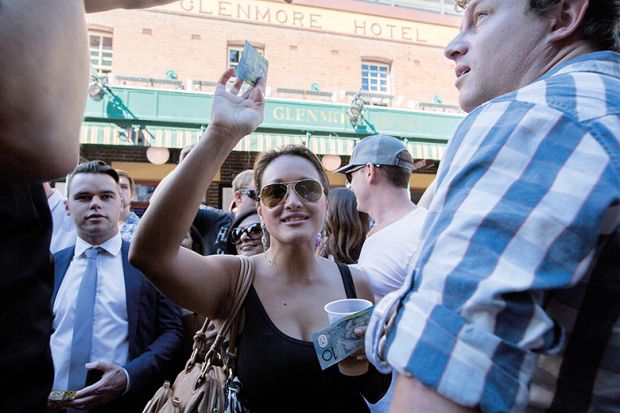Australian students should be able to pay full dollar for university places, a deputy vice-chancellor has proposed, reviving debate over a model critics saw as allowing rich students to buy their way into university.
Duncan Bentley, a researcher on taxpayers’ rights and deputy vice-chancellor (academic) at Swinburne University, says that Australia should reconsider a decade-old ban on full-fee places for domestic undergraduates – a model in which students self-funded their courses without any public subsidy – arguing that it no longer makes sense now that subsidised places have been capped.
“The government is saying there’s only a certain pot of money that it can afford,” said Professor Bentley. “Naturally we would all like to have as many places as possible, but the government’s saying there’s absolutely no way it’s going to give us that additional funding.
“There is no doubt of the fundamental merits of commonwealth-supported [publicly subsidised] places. The question, in a capped environment and [amid] increasing demand, is whether universities should be precluded from offering additional full-fee places to meet this demand.”
Full-fee places were introduced by then prime minister John Howard’s conservative government in 1996, as part of a shake-up of tuition fees. Universities that had used up their allotment of domestic undergraduate places were allowed to make additional places available to students prepared to meet the full costs.
The arrangement proved moderately popular, with about 2 per cent of Australian undergraduates paying full fees by 2008. But critics said the practice was elitist, allowing wealthy students to buy their way into university with school results up to five points lower than the merit-based admission scores.
In 2009, then Labor education minister Julia Gillard banned universities from enrolling any more full-fee domestic undergraduates. Months later she removed the need for full-fee places by promising to establish a demand-driven system, allowing universities to admit unlimited numbers of capable domestic undergraduates.
However, circumstances have changed again after the Coalition government axed the demand-driven system in late 2017. While limited growth in funded places will be permitted from next year, experts say it will not be enough to accommodate demand from school-leavers, whose numbers are projected to grow more than twice as quickly as the general population between 2022 and 2025.
Professor Bentley predicted “burgeoning demand” in fields such as health, education, science and technology. “Universities are not in a position to meet that demand unless the government uncaps those areas or allows full-fee places.”
He dismissed claims of elitism as a “furphy”, saying that full-fee places were already available in postgraduate courses – where they coexist with subsidised places – and almost existed in undergraduate law, economics and business degrees, where government subsidies cover just 16 per cent of course costs.
Professor Bentley said that universities juggling subsidised and full-fee places would allocate them in much the way they handled master’s places. People with most financial need and those with outstanding academic merit would be first in line for subsidised courses, he said.
Universities would only be able to offer full-fee places once they had used up their commonwealth-supported quotas, he added, while overall fees would be capped as at present. “That stops any gaming by universities trying to make more money out of students than they would from commonwealth-supported places,” he said.
Professor Bentley opposed “lenient” entry standards for full-fee students, arguing that people who did not meet admissions criteria should instead be channelled into “pedagogically supported” diploma pathway courses.
He also said a ban on full-fee sub-bachelor courses at universities should also be removed.
Under current arrangements, universities can only offer subsidised diploma places. This limitation “closes off a natural pathway to higher education”, denying university entry to capable but less academically prepared students, he argued.
It also puts universities at a competitive disadvantage compared with private colleges, which are allowed to teach full-fee diploma and bachelor’s students. “We can’t provide pathway places,” Professor Bentley said. “We have to ask [private providers such as] Navitas to do it for us.”
Representative group Independent Higher Education Australia said that the private sector’s role was to “fill the gaps” in public sector provision. And CEO Simon Finn said that while universities could not charge Australian undergraduates full fees, private colleges did not have access to government teaching subsidies – despite a recommendation to the contrary in the 2008 Bradley Review of Higher Education.
Mr Finn said that provider quality should determine access to funding. “Open public funding to quality providers whether they’re public or private,” he said. “Then it’s reasonable to be looking at competitive approaches to full-fee paying students.”
POSTSCRIPT:
Print headline: Australia’s full-fee places ban ‘should be revoked’
Register to continue
Why register?
- Registration is free and only takes a moment
- Once registered, you can read 3 articles a month
- Sign up for our newsletter
Subscribe
Or subscribe for unlimited access to:
- Unlimited access to news, views, insights & reviews
- Digital editions
- Digital access to THE’s university and college rankings analysis
Already registered or a current subscriber?










